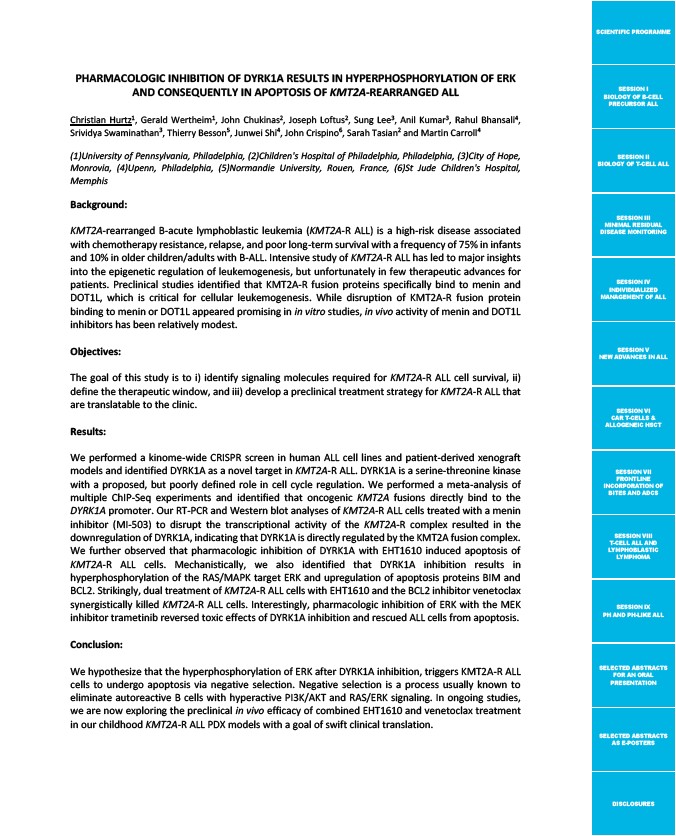
SCIENTIFIC PROGRAMME
SESSION I
BIOLOGY OF B-CELL
PRECURSOR ALL
SESSION II
BIOLOGY OF T-CELL ALL
SESSION III
MINIMAL RESIDUAL
DISEASE MONITORING
SESSION IV
INDIVIDUALIZED
MANAGEMENT OF ALL
SESSION V
NEW ADVANCES IN ALL
SESSION VI
CAR T-CELLS &
ALLOGENEIC HSCT
SESSION VII
FRONTLINE
INCORPORATION OF
BITES AND ADCS
SESSION VIII
T-CELL ALL AND
LYMPHOBLASTIC
LYMPHOMA
SESSION IX
PH AND PH-LIKE ALL
SELECTED ABSTRACTS
FOR AN ORAL
PRESENTATION
SELECTED ABSTRACTS
AS E-POSTERS
DISCLOSURES
PHARMACOLOGIC INHIBITION OF DYRK1A RESULTS IN HYPERPHOSPHORYLATION OF ERK
AND CONSEQUENTLY IN APOPTOSIS OF KMT2A-REARRANGED ALL
Christian Hurtz1, Gerald Wertheim1, John Chukinas2, Joseph Loftus2, Sung Lee3, Anil Kumar3, Rahul Bhansali4,
Srividya Swaminathan3, Thierry Besson5, Junwei Shi4, John Crispino6, Sarah Tasian2 and Martin Carroll4
(1)University of Pennsylvania, Philadelphia, (2)Children's Hospital of Philadelphia, Philadelphia, (3)City of Hope,
Monrovia, (4)Upenn, Philadelphia, (5)Normandie University, Rouen, France, (6)St Jude Children's Hospital,
Memphis
Background:
KMT2A-rearranged B-acute lymphoblastic leukemia (KMT2A-R ALL) is a high-risk disease associated
with chemotherapy resistance, relapse, and poor long-term survival with a frequency of 75% in infants
and 10% in older children/adults with B-ALL. Intensive study of KMT2A-R ALL has led to major insights
into the epigenetic regulation of leukemogenesis, but unfortunately in few therapeutic advances for
patients. Preclinical studies identified that KMT2A-R fusion proteins specifically bind to menin and
DOT1L, which is critical for cellular leukemogenesis. While disruption of KMT2A-R fusion protein
binding to menin or DOT1L appeared promising in in vitro studies, in vivo activity of menin and DOT1L
inhibitors has been relatively modest.
Objectives:
The goal of this study is to i) identify signaling molecules required for KMT2A-R ALL cell survival, ii)
define the therapeutic window, and iii) develop a preclinical treatment strategy for KMT2A-R ALL that
are translatable to the clinic.
Results:
We performed a kinome-wide CRISPR screen in human ALL cell lines and patient-derived xenograft
models and identified DYRK1A as a novel target in KMT2A-R ALL. DYRK1A is a serine-threonine kinase
with a proposed, but poorly defined role in cell cycle regulation. We performed a meta-analysis of
multiple ChIP-Seq experiments and identified that oncogenic KMT2A fusions directly bind to the
DYRK1A promoter. Our RT-PCR and Western blot analyses of KMT2A-R ALL cells treated with a menin
inhibitor (MI-503) to disrupt the transcriptional activity of the KMT2A-R complex resulted in the
downregulation of DYRK1A, indicating that DYRK1A is directly regulated by the KMT2A fusion complex.
We further observed that pharmacologic inhibition of DYRK1A with EHT1610 induced apoptosis of
KMT2A-R ALL cells. Mechanistically, we also identified that DYRK1A inhibition results in
hyperphosphorylation of the RAS/MAPK target ERK and upregulation of apoptosis proteins BIM and
BCL2. Strikingly, dual treatment of KMT2A-R ALL cells with EHT1610 and the BCL2 inhibitor venetoclax
synergistically killed KMT2A-R ALL cells. Interestingly, pharmacologic inhibition of ERK with the MEK
inhibitor trametinib reversed toxic effects of DYRK1A inhibition and rescued ALL cells from apoptosis.
Conclusion:
We hypothesize that the hyperphosphorylation of ERK after DYRK1A inhibition, triggers KMT2A-R ALL
cells to undergo apoptosis via negative selection. Negative selection is a process usually known to
eliminate autoreactive B cells with hyperactive PI3K/AKT and RAS/ERK signaling. In ongoing studies,
we are now exploring the preclinical in vivo efficacy of combined EHT1610 and venetoclax treatment
in our childhood KMT2A-R ALL PDX models with a goal of swift clinical translation.